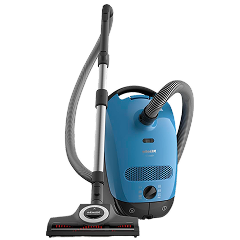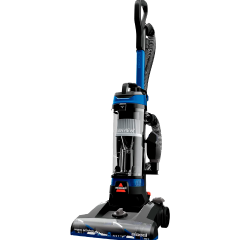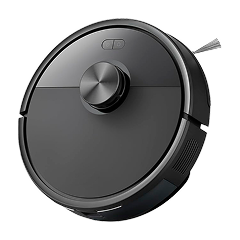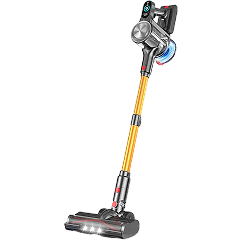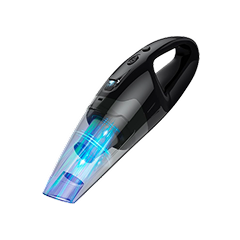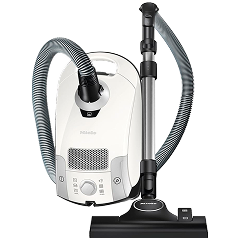Si alguna vez sientes que tus encimeras, la mesa de la cocina y los asientos del coche siempre están sucios, deberías considerar comprar una aspiradora de mano. Son aspiradoras pequeñas que se pueden colocar prácticamente en cualquier lugar con una toma de corriente y siempre están a mano cuando las necesitas.
El problema es que necesitas una que se adapte a la situación. Por ejemplo, una aspiradora de mano diseñada para limpiar entre los asientos del coche no es óptima para una cocina. Puedes encontrar la adecuada eligiendo un modelo con funciones especializadas para los problemas más comunes del hogar.
He trabajado como probador y revisor de aspiradoras durante más de una década y esto es lo que he aprendido sobre las aspiradoras de mano.
Cómo elegir la aspiradora de mano sin cable adecuada
Opciones de carga
El método de carga define las expectativas básicas sobre el uso que le darás a tu aspiradora de mano para casa. Una aspiradora de mano compatible con 12 voltios, a veces llamada “mechero”, puede llevarse en el coche. Una con adaptador USB puede conectarse a tu ordenador de escritorio o portátil.
Además de si se puede cargar la aspiradora portátil, también se debe considerar el tipo de carga. Algunos modelos portátiles tienen una placa de carga sobre la que se coloca la aspiradora. Esto facilita el acceso, pero también ocupa más espacio que una simple toma de corriente.
Duración de la batería
La duración de la batería se refiere al tiempo que puedes usar la aspiradora de mano sin cable para limpiar. Cuando las marcas indican la duración de la batería, suele basarse en la configuración más baja. En mi experiencia, puedes conseguir que la batería dure más en la configuración más alta reduciendo a la mitad el tiempo indicado. Por lo tanto, una duración de batería de 20 minutos se convierte en 10 minutos en la configuración más alta.
Una buena duración de batería depende del tamaño del área que se desee limpiar con regularidad. Por ejemplo, si te compras una aspiradora inalámbrica para limpiar migas en la mesa de la cocina, una batería de 10 minutos será suficiente. Sin embargo, si esperas limpiar todo el pelo de la cama del perro, se necesita una batería más robusta.
Poder de succión
Hay tres maneras principales en que las marcas indican la potencia de succión de una aspiradora de mano: vatios de aire y pascales. Los vatios de aire se calculan multiplicando la potencia de succión por el flujo de aire y dividiendo ese número entre 8,5. Los pascales son una medida de presión en relación con la atmósfera. Por ejemplo, 4.000 pascales representan aproximadamente el 0,4 % de la presión total de la atmósfera que se ejerce sobre ti en este momento.
Puede ser un poco complicado decidir cuál es un número “bueno” para estas métricas porque algunas aspiradoras de mano son inalámbricas y no tienen varilla ni cabezal de cepillo.
Sin embargo, en general, cualquier potencia superior a 50 vatios de aire o 5.000 pascales es suficiente para aspirar migas. Creo que la potencia de succión es menos importante que cómo se utiliza a través de los accesorios de la aspiradora.
Accesorios
La mayoría de las aspiradoras de mano no incluyen una amplia variedad de accesorios. Por lo tanto, su mejor uso dependerá de los que traiga.
Si solo incluye una boquilla para rincones, un tubo largo y delgado con punta triangular, será ideal para acceder entre cojines, detrás de muebles y en espacios reducidos. A menudo, la boquilla para rincones incluye cerdas para polvo, que ayudan a eliminar migas y residuos. Necesitas una aspiradora de mano con cabezal de cepillo si deseas limpiar el pelo de mascotas de los cojines o la cama de tu mascota.
Capacidad de residuos
La capacidad de residuos se refiere a la cantidad de suciedad y restos que una aspiradora puede retener antes de tener que vaciarse. Al igual que la duración de la batería, se traduce en cuánta limpieza se puede realizar de una sola vez. Esto es especialmente importante si se trata de suciedad de gran volumen, como pelos de mascotas.
Cualquier aspiradora portátil con una capacidad de 300 ml o menos se considera muy pequeña, pero será suficiente si buscas una aspiradora solo para tu escritorio o encimera. Por otro lado, una capacidad superior a 500 ml es considerable.
Filtros
Probablemente hayas oído hablar de los filtros HEPA, diseñados para eliminar partículas finas. O quizás te interese un filtro impregnado de carbón para reducir los olores. Si bien son bastante comunes en las aspiradoras grandes, son mucho menos comunes en las portátiles.
Como mínimo, puedes esperar un filtro de malla. Estos suelen estar hechos de una red de alambres de plástico que ayuda a evitar que escapen residuos grandes y grumos de polvo. La falta de un filtro más fino se debe a que muchas aspiradoras de mano están diseñadas para limpiar pequeñas manchas cuando tus hijos derraman cereales en el suelo.
En el lado positivo, los filtros de malla generalmente son lavables y requieren reemplazo con menos frecuencia.
Si deseas ese filtro de gama alta, tendrás que buscar aspiradoras de mano que hayan sido convertidas de un modelo inalámbrico grande. Estos modelos portátiles tienen el mismo motor y filtro, pero la marca ha eliminado la varilla que conecta el cabezal del cepillo y, por lo general, reduce la cantidad de accesorios disponibles.
Peso
A diferencia de otros tipos de aspiradoras, una aspiradora de mano no hace contacto con el suelo. Esto significa que la fuerza del brazo se mantiene activa constantemente mientras se limpia. Una aspiradora más ligera suele sacrificar la duración de la batería y la potencia de succión.
Cuanto más pesada sea la aspiradora, más fatigoso será utilizarla y el resultado final es que podrías acabar utilizándola menos.
Aspiradoras de mano: características especiales
Función húmedo/seco
Existen aspiradoras de mano que pueden aspirar residuos y agua por igual. Tener una aspiradora para líquidos/seco en la palma de la mano es una excelente manera de reducir el uso de papel de cocina.
Luces LED
Algunas aspiradoras de mano incorporan luces LED. Estas luces brillantes ayudan a iluminar la suciedad y los residuos en lugares oscuros, como debajo de los muebles.
Manguera extensible
Si alguna vez buscaste la flexibilidad de una aspiradora de contenedor, pero que puedas transportar fácilmente, deberías buscar una aspiradora de mano compatible con una manguera extensible. Te da más alcance y te permite tener una mano libre mientras limpias. Por ejemplo, si necesitas levantar la tapa de la consola central del coche, puedes hacerlo sin tener que usar el codo o la frente.
Aspiradoras de teclado
Esto es más una categoría completa que una característica, pero quería incluirlo porque sé que para alguien será un momento de “¡Vaya!”.
Las aspiradoras de teclado son unidades muy pequeñas que pueden succionar y soplar. Se usan para mantener limpios los dispositivos electrónicos y para ciertos proyectos artísticos. Imagínalas como una lata recargable de aire comprimido.
Marcas de aspiradoras de mano: pros y contras
Bissell
La marca Bissell ofrece varias líneas de aspiradoras portátiles con cepillos motorizados. Se centran en la limpieza de pelos de mascotas y tapicerías. Según mi experiencia, están disponibles en muchísimas tiendas, así que siempre hay una en oferta.
Black+Decker
Black+Decker es más conocida por sus herramientas eléctricas. Sin embargo, también ofrece una amplia variedad de aspiradoras de mano. Vienen en todos los tamaños y formas, con diversas funciones. Hay modelos que pueden aspirar suciedad húmeda y otros que se especializan en recoger pelo de mascotas.
Cuando probé las aspiradoras Black+Decker, la mayor desventaja que encontré fue que la duración de la batería tendía a ser inferior a 10 minutos por carga.
Ryobi
Ryobi es conocido principalmente como fabricante de herramientas eléctricas. Sin embargo, sus aspiradoras de mano son bastante buenas. Una gran ventaja de las aspiradoras de mano Ryobi es que funcionan con la misma batería que sus herramientas eléctricas de 18 voltios.
Esto significa que puedes quitar la batería de tu taladro y conectarla a tu aspiradora de mano. Una batería de 18 voltios significa que las aspiradoras de mano Ryobi suelen ser mucho más potentes que las de la competencia. La desventaja es que son exclusivas de Home Depot.
Dyson
Es común que Dyson reestructure las aspiradoras inalámbricas más vendidas como unidades de mano, quitándoles el tubo y algunos accesorios. Obtendrás la misma potencia y los mismos filtros que las aspiradoras Dyson. Sin embargo, seguirás teniendo que pagar los precios de Dyson para conseguirlas. Es una buena manera de comprobar si te gusta el producto y el diseño.
Errores comunes al comprar una aspiradora de mano para casa
Conseguir una que sea demasiado voluminosa para tus necesidades
A menudo caemos en la trampa de “cuanto más grande, mejor”. Sin embargo, una aspiradora de mano está diseñada para ser una herramienta práctica que ayuda a cubrir las necesidades de limpieza que tu otra aspiradora no puede cubrir. A menudo se usan para limpiar coches y debajo de los cojines, lugares donde podrías adoptar posiciones incómodas para llegar a la suciedad. Por eso, conseguir una aspiradora ligera y maniobrable es una gran ventaja.
Los dueños de mascotas no compran una con un mini-cepillo
Si esperas que tu aspiradora de mano te ayude a eliminar el pelo suelto de tu casa, necesitas una con minicepillo. Los cepillos giratorios motorizados son los que arrancan los folículos de alfombras y cojines.
Quizás puedas arreglártelas con un cepillo de tapicería manual, pero eso implicará mucho trabajo.


